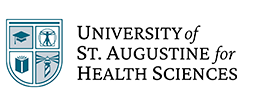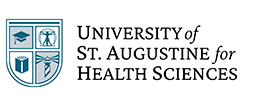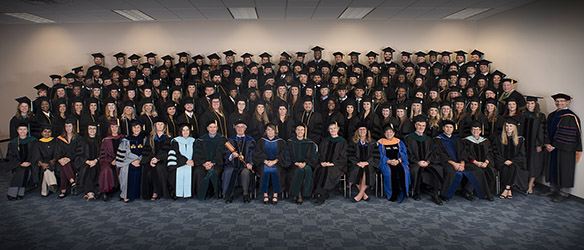
What does SLP stand for? A speech-language pathologist (SLP) diagnoses and treats issues related to speech, language, communication and swallowing disorders.1 For patients who struggle to communicate or swallow, these healthcare professionals help them to better engage with the world around them.
What is a speech pathologist’s career outlook? Read on to learn more about this exciting and promising field of work.
Table of Contents:
- What Do Speech-Language Pathologists Do?
- Where Do Speech-Language Pathologists Work?
- What Conditions Do Speech-Language Pathologists Treat?
- FAQ
- Earn Your MS-SLP at USAHS
What Does a Speech Pathologist Do?
What is a speech-language pathologist? SLPs are communication specialists who treat speech, language, communication and swallowing disorders.1
What does a speech pathologist do for their patients on a day-to-day basis? As part of their work, they may provide the following services: 2,1
- Evaluate and diagnose speech, language, voice and fluency disorders in children and adults
- Develop therapies to help patients improve their ability to swallow
- Identify treatment goals for patients
- Design and implement individualized treatment plans, including speech therapy activities, to help patients meet their treatment goals
- Provide aural rehabilitation for people who are deaf or hard of hearing


- Teaching patients how to make sounds
- Helping patients improve their voices
- Training patients to maintain fluency when speaking
- Developing exercises to strengthen the muscles used for swallowing
- Sharing vocabulary improvement strategies with patients
- Assisting patients with strategies to improve their sentence structure
- Demonstrating how to use augmentative and alternative communication (AAC) systems to communicate
Speech-language pathologists may also spend time helping patients and their families navigate their disability and treatment options.2 Many speech-language pathologists work as part of a larger healthcare team, including physicians and occupational therapists (OTs) or physical therapists (PTs).


Where Do Speech-Language Pathologists Work?
What is a speech pathologist’s typical work environment? Speech-language pathologists often work in a variety of settings. The largest employers of speech-language pathologists were as follows:
| Setting | Percentage4 |
|---|---|
| Education services | 42% |
| Offices of physical, occupational and speech therapists and audiologists | 25% |
| Hospitals | 14% |
| Nursing and residential care facilities | 4% |
| Self-employed workers | 3% |
What is a speech-language pathologist’s role in childhood development? Over half of SLPs work as a part of early intervention programs, preschools or K-12 schools.3,4 In addition to the regular duties of a speech-language pathologist, they also develop individualized education programs (IEPs) and collaborate with other educators to ensure students are meeting their educational goals.
Healthcare settings for speech-language pathologists include the following: 4, 5
- Assisted living facilities
- Private practices and clinics
- Rehabilitation centers
- Long-term care facilities
- Hospitals
- Home health agencies
Some speech-language pathologists also work in corporate settings.4 What is an SLP’s duty in such settings? They may work with employees on business speaking skills, such as presentation, accent modification or interviewing.
Local, state and federal government agencies hire speech-language pathologists for public health services.4 The military also employs speech-language pathologists to work with service members and underserved populations.
If you don’t want to work in a clinical setting, you can pursue a role in research or teach at the college or university level.1
With the high demand for speech-language pathologists, SLPs may work full- or part-time.1
What Conditions Do Speech-Language Pathologists Treat?
What is a speech-language pathologist’s role in treating various conditions? They provide solutions for a range of disorders caused by trauma, illness, developmental delays and medical events such as strokes.2


Speech-language pathologists often treat speech disorders, including:5
- Articulation disorders: Difficulty controlling muscle movements to create sound
- Phonological disorders: Sounds that are formed correctly in the muscles but don’t sound the way they should
- Resonance disorders: Disruption of sound waves due to conditions such as a cleft palate
- Speech impairments: Various conditions that make it difficult for a person to communicate and be understood, such as childhood apraxia of speech and stuttering
What do speech pathologists do to help patients improve? A speech-language pathologist may work with patients struggling with language disorders such as:1,5
- Problems with receptive language (the ability to understand others)
- Problems with expressive language (the ability to share their ideas and feelings)
- Verbal communication
- Written communication
- Selective language impairment
- Aphasia
Speech-language pathologists also treat social communication disorders, including any condition relating to verbal and nonverbal communication in social settings.1 Individuals with autism or traumatic brain injuries also struggle with social communication disorders5,1
Patients with cognitive communication disorders—often the result of stroke, traumatic brain injury or dementia—may also work with a speech-language pathologist.1 These issues include difficulties with:
- Organizing thoughts
- Paying attention
- Remembering
- Planning
- Problem-solving
Speech-language pathologists also treat swallowing disorders that may occur due to illness, surgery, stroke or injury.1,5
Additionally, someone may seek treatment from a speech-language pathologist for issues related to the vocal cord, such as lesions and paralysis or for gender-affirming voice therapy.5
Is this true, or is it more accurate to say: Individuals with autism or TBIs also struggle with social communication disorders.


FAQ
Learn more about a career in speech-language pathology with answers to these common questions.
What Is a Speech-Language Pathologist, and How Do They Differ From a Speech Therapist?
When it comes to SLP meaning, a speech-language pathologist and a speech therapist are the same thing, but speech-language pathologist is the preferred term.5
How Much Does a Speech-Language Pathologist Make?
What is a speech pathologist typically earning per year? The median annual salary for a speech-language pathologist is $89,290.6 Your salary will depend on factors like your experience, location and industry.
What Specialties Are Available in Speech-Language Pathology?
What is a speech-language pathologist’s career outlook? There are four specialties available for speech-language pathologists:7
- Child Language (BCS-CL) from the American Board of Child Language and Language Disorders8
- Stuttering, Cluttering and Fluency Disorders (BCS-SCF) from the American Board of Fluency and Fluency Disorders9
- Swallowing and Swallowing Disorders (BCS-S) from the American Board of Swallowing and Swallowing Disorders10
- Intraoperative Monitoring (BCS-IOM) from the American Audiology Board of Intraoperative Monitoring11
Requirements vary based on the type of specialty but generally involve an exam, portfolio review or interview to assess your skills and expertise in the specialty area.
What Is the Role of a Speech Pathologist?
A speech-language pathologist (SLP) plays a crucial role in diagnosing and treating communication and swallowing disorders.1 What is a speech pathologist’s main responsibility? They work with patients of all ages to develop personalized treatment plans that address issues such as speech articulation, language comprehension, and social communication skills.


Earn Your MS-SLP with USAHS
“Having practiced with all this technology, I was so much more prepared for my job than my coworkers who went to other schools. I knew just what to do on my first day and now I’m teaching my coworkers about what I learned.”
– Bethany W., USAHS MS-SLP Alum
What is an SLP rewarded with as a result of their hard work? There are many benefits to being a speech-language pathologist, including an impressive salary, job security and the opportunity to make a difference in patient lives.
Pursue your dream of becoming a speech-language pathologist at the University of St. Augustine for Health Sciences (USAHS). Our hybrid online Master of Science in Speech-Language Pathology (MS-SLP) program allows students to take classes online and still engage in hands-on experience.
The USAHS program takes about five trimesters with three different intake dates (spring, summer and fall) to allow for flexibility.*
Our program does not require a GRE, and you’ll have access to state-of-the-art technology and virtual and in-person clinical practicum opportunities, including a pro-bono clinic.
Talk with an enrollment advisor and apply today.
*Time to completion may vary by student, depending on individual progress, credits transferred, and other factors.
The Master of Science (M.S.) education program in Speech-Language Pathology {residential Austin, TX; satellite Dallas, TX; both distance education} at the University of St. Augustine for Health Sciences is accredited by the Council on Academic Accreditation in Audiology and Speech-Language Pathology (CAA) of the American Speech-Language-Hearing Association, 2200 Research Boulevard, #310, Rockville, MD 20850, 800-498-2071 or 301-296-5700.
Sources
- American Speech-Language-Hearing Association, “Speech-Language Pathologists,” ASHA, 2024, https://www.asha.org/students/speech-language-pathologists/.
- U.S. Bureau of Labor Statistics, “Speech-Language Pathologists: What Speech-Language Pathologists Do,” BLS, April 17, 2024, https://www.bls.gov/ooh/healthcare/speech-language-pathologists.htm#tab-2.
- U.S. Bureau of Labor Statistics, “Speech-Language Pathologists: Work Environment,” BLS, April 17, 2024, https://www.bls.gov/ooh/healthcare/speech-language-pathologists.htm#tab-3.
- American Speech-Language-Hearing Association, “Employment Settings for SLPs,” ASHA, 2024, https://www.asha.org/students/employment-settings-for-slps/.
- Cleveland Clinic, “Speech-Language Pathologist,” Cleveland Clinic, January 12, 2023, https://my.clevelandclinic.org/health/articles/24602-speech-language-pathologist.
- U.S. Bureau of Labor Statistics, “Speech-Language Pathologists: Pay,” BLS, April 17, 2024, https://www.bls.gov/ooh/healthcare/speech-language-pathologists.htm#tab-5 .
- American Speech-Language-Hearing Association, “Clinical Specialty Certification,”ASHA, 2024, https://www.asha.org/certification/clinical-specialty-certification/.
- American Board of Child Language & Language Disorders, “Applying for Specialty Certification,” ABCLLD, 2021, https://www.childlanguagespecialist.org/applicants/
- American Board of Fluency and Fluency Disorders, “BCS-SCF Candidates,”American Board of Fluency and Fluency Disorders, 2024, https://www.stutteringspecialists.org/candidates.
- American Board of Swallowing and Swallowing Disorders, “Requirements for Applicants,”ABSSD, https://www.swallowingdisorders.org/page/Requirements.
- American Audiology Board of Intraoperative Monitoring, “Membership Application,” AABIOM, 2018, https://www.aabiom.com/application.






